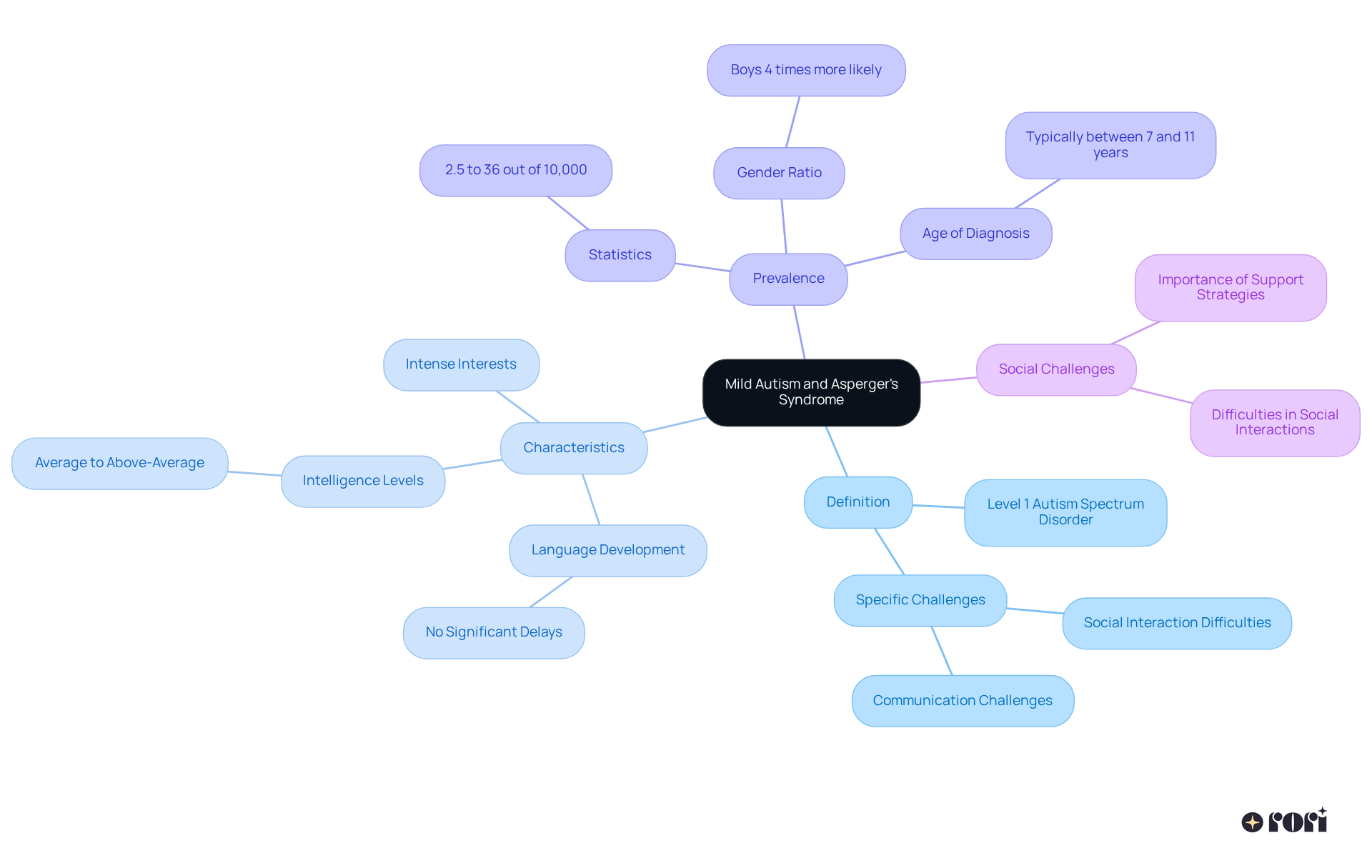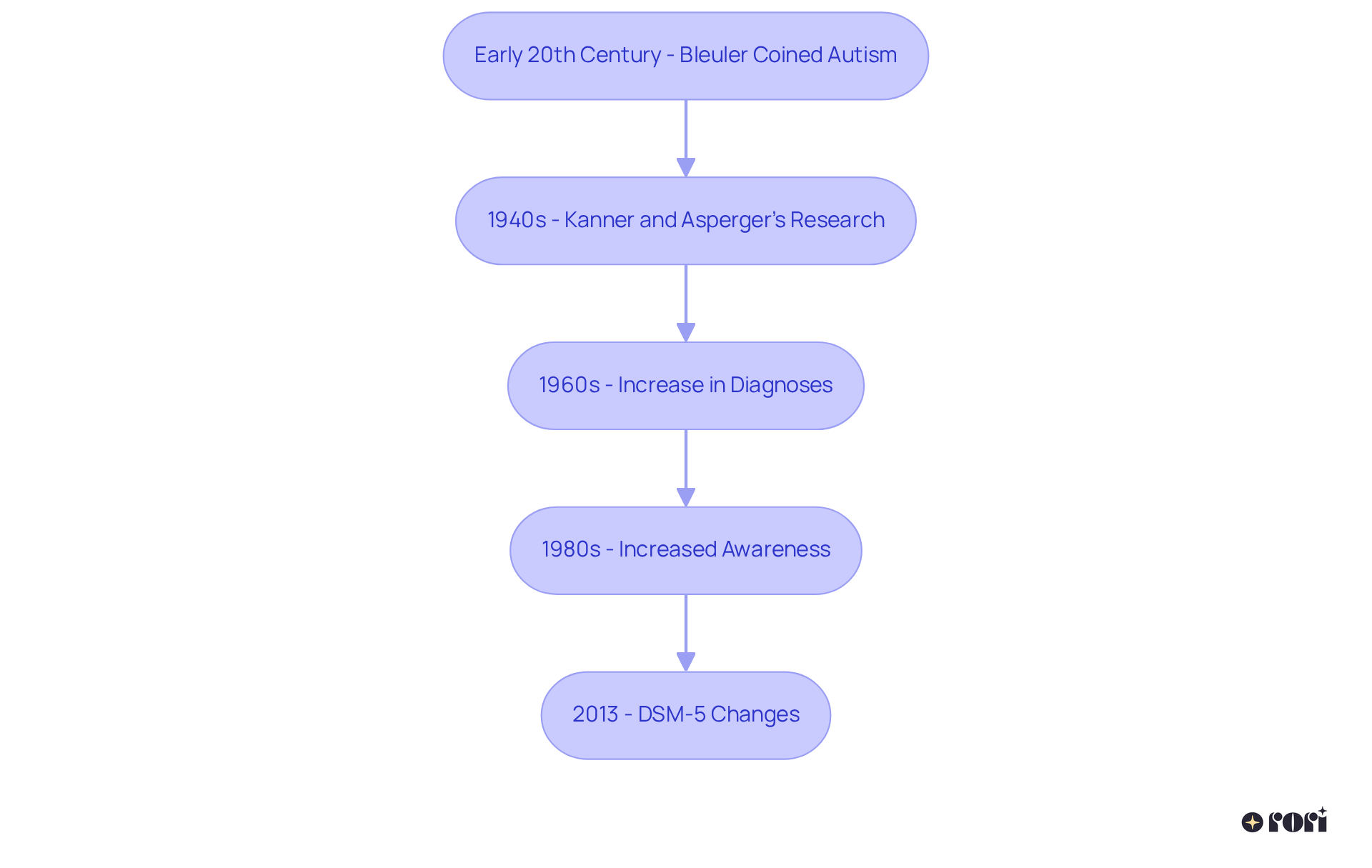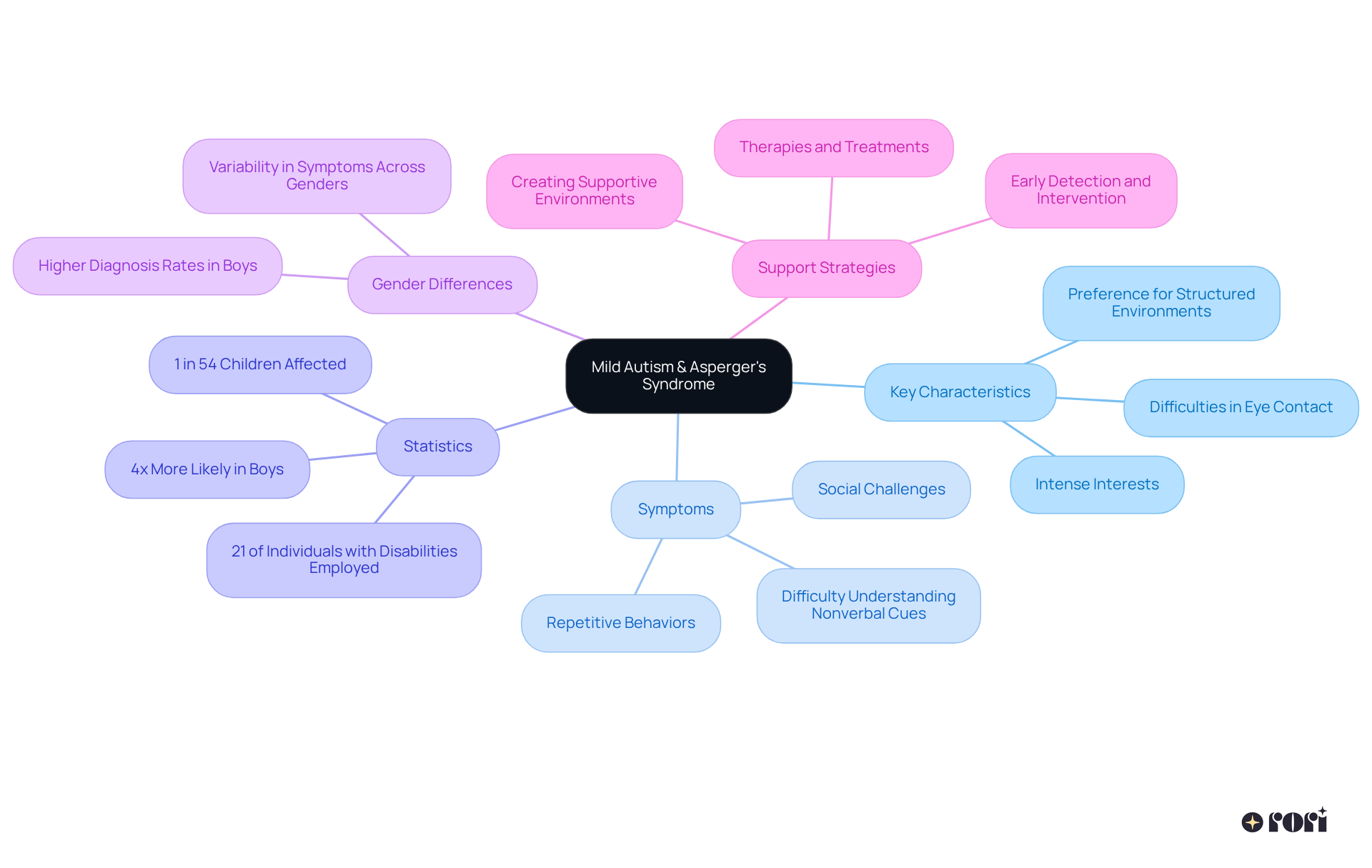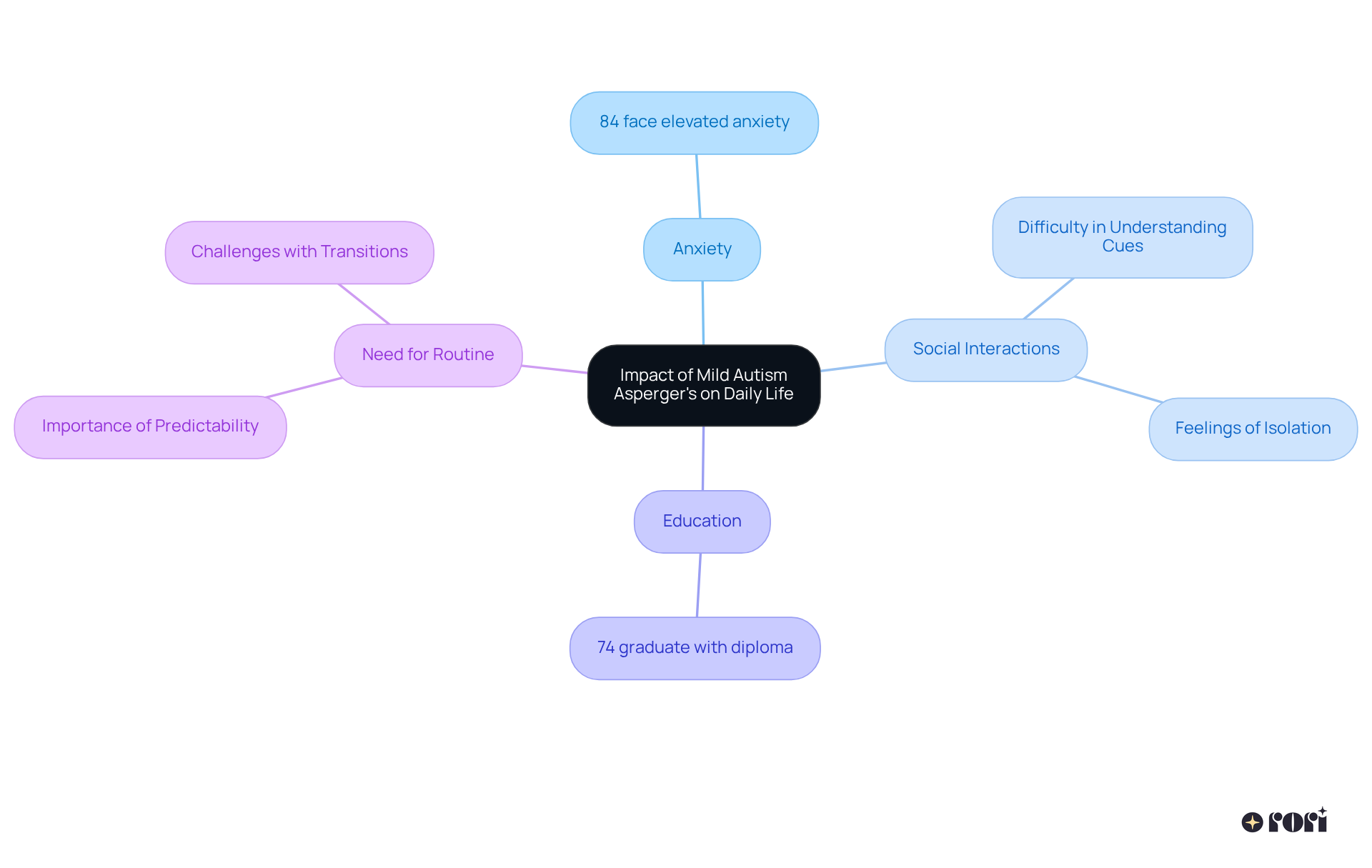Mild autism Asperger's, which falls under Level 1 Autism Spectrum Disorder, brings its own set of challenges, especially in social interactions and communication. Interestingly, individuals with this condition often don’t face significant delays in language development or cognitive skills. However, they may feel anxious in social situations and can struggle with understanding social cues. This highlights the importance of tailored support and interventions to help improve their daily lives and foster better social integration.
Let’s explore this together! Many parents share similar experiences, feeling a mix of concern and hope as they navigate these challenges. With the right resources and understanding, we can make a difference in their lives. Remember, you’re not alone in this journey, and seeking help is a positive step toward creating a supportive environment for your child.
Understanding mild autism, especially Asperger's syndrome, opens up a world filled with social challenges and unique strengths. Individuals with this condition often find themselves in an overwhelming environment, facing difficulties in social interactions. Yet, they also possess an incredible ability to focus intensely and showcase intelligence in specific areas.
As awareness increases, so does the pressing question: how can we better support those with mild autism and Asperger's to thrive both academically and socially?
Exploring this topic not only highlights the characteristics and historical context of the condition but also underscores the importance of tailored interventions and understanding. Let’s explore this together!
The condition known as Level 1 Autism Spectrum Disorder (ASD) is mild autism Aspergers, characterized by individuals who display fewer and less severe symptoms than those with other forms of the disorder. Asperger's condition, now part of the ASD umbrella, is characterized by specific challenges in social interaction and communication. Unlike other autism diagnoses, those with Asperger's syndrome usually don't face significant delays in language development or cognitive skills. Many have average to above-average intelligence and may develop intense interests in certain subjects, which can sometimes make social integration a bit tricky.
Recent studies reveal that Asperger's condition occurs in about 2.5 to 36 out of every 10,000 individuals, with boys being at least four times more likely to receive a diagnosis than girls. Typically, the diagnosis happens between the ages of 7 and 11 years, highlighting the importance of early intervention. In a broader context, it's estimated that 1 in 31 children in the U.S. has autism, which is mild autism Aspergers, helping us understand better along with related conditions. Social interaction difficulties are common, as individuals may struggle to read social signals and engage in back-and-forth conversations, leading to feelings of isolation. Understanding these nuances is key to developing effective support strategies and interventions tailored to the unique needs of those on the autism spectrum.
Let’s explore this together! We’re here to help you every step of the way!

The term 'autism' first came into play in the early 20th century, thanks to Swiss psychiatrist Eugen Bleuler. He used it to describe a symptom of schizophrenia. Fast forward to the 1940s, and we see Leo Kanner and Hans Asperger independently identifying unique behavioral patterns in children. This was a significant moment, leading to the official recognition of developmental disorders, including Asperger's condition.
Kanner focused on children who showed severe social withdrawal, while Asperger's research highlighted those with average intelligence who faced their own social challenges. This differentiation laid the groundwork for understanding the diverse conditions on the autism spectrum, particularly what is mild autism Aspergers. Since the 1960s, we've seen a remarkable increase in diagnoses, reflecting a growing awareness and understanding of autism.
In the 1980s, researchers' contributions gained significant attention, further boosting awareness. A report from 2011-12 revealed a prevalence rate of 1 in 50 among children aged 6-17 in the USA, showcasing the current landscape of diagnoses. Then in 2013, the DSM-5 made a notable change by stating that Asperger's syndrome is mild autism Aspergers, incorporating it into the broader category of Autism Spectrum Disorder (ASD). This shift aimed to streamline diagnosis and treatment, recognizing that one aspect of the spectrum is mild autism aspergers, along with the varying social and communication difficulties individuals experience.
The founding of the UK Society for Autistic Children in 1962 marked a crucial milestone in advocacy and recognition of autism. The evolution of these terms reflects our ongoing journey toward a deeper understanding of autism and its manifestations. As Bonnie Evans wisely noted, 'Autism has always referred to the most severe pathology in infantile thought, and changes in its meaning reflect broader historical changes in what is considered abnormal in the thought and behavior of all infants and children.'
Let’s explore this together and continue to foster understanding and support for each other!

A condition that is mild autism Asperger's is characterized by a variety of traits that can significantly impact individuals' daily lives. You might notice common symptoms like difficulties with interpersonal interactions—trouble making eye contact or initiating conversations can be quite challenging. These individuals may struggle to understand nonverbal cues, which can lead to misunderstandings in social situations. Plus, they often exhibit repetitive behaviors or routines and may develop intense interests in specific topics, resulting in deep knowledge in those areas.
Recent findings indicate that a characteristic of children with Asperger's syndrome is mild autism Asperger's, as they may prefer structured environments, providing them with a sense of security and predictability. While many excel academically, they frequently encounter difficulties with interpersonal nuances, leading to feelings of isolation. For instance, imagine a child who shines in math but finds it tough to engage in casual conversations with peers. This highlights the contrast between their academic strengths and social challenges.
Statistics show that this condition is estimated to impact 1 in 54 children in the United States, and boys are four times more likely to receive a diagnosis than girls. This really underscores the importance of awareness and understanding of how these symptoms can present differently across genders. Moreover, it’s significant to acknowledge that 21% of individuals with disabilities, including those on the spectrum, are employed. This offers insight into the long-term outcomes for individuals with related conditions.
Grasping these traits is vital for parents and educators to provide the essential support and resources for children, as mild autism Asperger's is a condition that allows them to truly flourish in a supportive atmosphere. As Ralph Moller states, "There is no remedy for the condition, but there are many treatments and therapies that can help manage symptoms." This viewpoint emphasizes the importance of early detection and intervention, which can significantly enhance outcomes for children on the autism spectrum. Let’s explore this together and see how we can support these amazing kids on their journey!

The effects of mild autism Asperger's on daily life can be quite significant. Many individuals often feel a wave of anxiety in public situations, which might lead them to avoid gatherings and events altogether. Did you know that research shows up to 84% of young autistic individuals face clinically elevated anxiety? This really highlights how common anxiety is in this community.
Navigating social interactions can be tricky too. Grasping interpersonal cues and norms—like engaging in conversations, expressing emotions, or even making eye contact—can be challenging. This can make it hard to form and maintain friendships, sometimes leading to feelings of isolation.
In school, while many students shine academically, they often need extra support to engage in group work and collaborative projects. Statistics reveal that 74% of autistic students graduate with a diploma, compared to 86% of all students. This shows the unique challenges they encounter in educational settings.
The need for routine and predictability can add another layer of complexity. Transitions or unexpected changes can feel overwhelming, so tailored strategies are essential to help manage these situations. Insights from psychologists remind us how crucial it is to recognize these social interaction difficulties. The condition that they can significantly impact overall well-being and quality of life for individuals is mild autism Asperger's.
Plus, untreated anxiety can disrupt not just academic performance but also relationships. This really underscores the importance of effective support and intervention. We’re here to help you every step of the way! Let’s explore this together!

Mild autism Asperger's, now recognized under the broader Autism Spectrum Disorder (ASD) classification, presents unique challenges and strengths in individuals. Understanding this condition is crucial, as it encompasses specific social interaction difficulties and communication styles that set it apart from other forms of autism. The insights shared throughout this article illuminate the importance of recognizing these nuances to foster a supportive environment for those affected.
We’ve highlighted key characteristics of mild autism Asperger's, like intense interests, challenges in picking up social cues, and the prevalence of anxiety. It’s fascinating to see how the historical context of autism terminology has evolved, emphasizing the need for early diagnosis and tailored interventions. By grasping these distinctive traits and symptoms, we can all work together—parents, educators, and society—to provide the necessary support for individuals on the spectrum.
As awareness continues to grow, it’s becoming increasingly vital to advocate for effective strategies that promote inclusion and understanding. The journey toward acceptance and support for those with mild autism Asperger's is ongoing, and every effort counts. Let’s embrace the unique perspectives and abilities of individuals on the spectrum, leading to a richer, more inclusive society where everyone has the opportunity to thrive. We’re here to help you every step of the way!
What is mild autism, also known as Asperger's Syndrome?
Mild autism, or Asperger's Syndrome, is classified as Level 1 Autism Spectrum Disorder (ASD). It is characterized by fewer and less severe symptoms compared to other forms of autism, with specific challenges in social interaction and communication.
How do individuals with Asperger's Syndrome differ from those with other autism diagnoses?
Individuals with Asperger's Syndrome typically do not experience significant delays in language development or cognitive skills. Many have average to above-average intelligence and may develop intense interests in specific subjects, which can complicate social integration.
What is the prevalence of Asperger's Syndrome?
Recent studies indicate that Asperger's Syndrome occurs in about 2.5 to 36 out of every 10,000 individuals, with boys being at least four times more likely to be diagnosed than girls.
At what age is Asperger's Syndrome typically diagnosed?
The diagnosis of Asperger's Syndrome usually occurs between the ages of 7 and 11 years, emphasizing the importance of early intervention.
How common is autism in children in the U.S.?
It is estimated that 1 in 31 children in the U.S. has autism, which includes mild autism, or Asperger's Syndrome.
What are some common difficulties faced by individuals with Asperger's Syndrome?
Individuals with Asperger's Syndrome often struggle with social interaction, including reading social signals and engaging in back-and-forth conversations, which can lead to feelings of isolation.
Why is understanding Asperger's Syndrome important?
Understanding the nuances of Asperger's Syndrome is crucial for developing effective support strategies and interventions tailored to the unique needs of those on the autism spectrum.